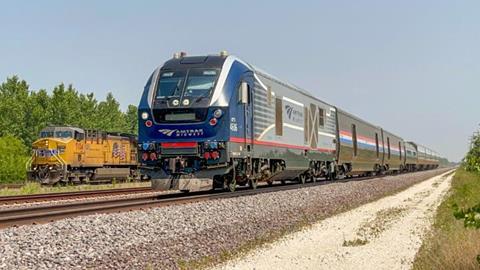
USA: Accelerated inter-city passenger services running at up to 177 km/h were launched on the 457 km Chicago – Springfield – St Louis route on June 26.
Celebrations were held at Union Station in Chicago attended by Illinois State Governor JB Pritzker and other officials to mark completion of work to enable faster operation of Amtrak’s state-supported Lincoln service.
The end-to-end journey has been accelerated by approximately 30 min, reducing the travel time to less than 5 h. The line speed limit has been formally raised from the previous 145 km/h to 177 km/h, which yielded a 15 min journey time saving, but in practice a restriction of 127 km/h was in place at the time the route modernisation project began, hence the larger cut in travel time.
‘Shining example’
The heavily delayed project to enhance the line speed on the route, which is mostly owned by Union Pacific, began in 2010 and was originally due for completion by 2017.
The $1·96bn overall cost was largely funded through the federal government’s high speed rail programme, but the upgrading work was mainly carried out by UP, which in a statement issued on June 26 described the route modernisation as ‘a shining example’ of how freight railroads and passenger services ‘can co-exist and benefit from public-private partnerships and investments in rail infrastructure’.
Investment included double-tracking of 91 km of the line, and enhancement of the signalling to cope with the higher speeds. Bridges and culverts were reconstructed, and concrete sleepers installed.
No fewer than 212 level-crossings were upgraded by installing four-quadrant gates and object detectors to help prevent collisions. The corridor has been fenced throughout and dedicated pedestrian foot crossings installed; some 39 crossing points deemed too unsafe were closed.
Mark Bristol, General Director for Interline Operations at Union Pacific, said that ‘the most unique thing about this project is that we tried to find a way to successfully run freight trains that are going 90 km/h and passenger trains going 177 km/h on the same track’.

This necessitated a series of enhancements to be made to the Positive Train Control equipment deployed along the route to facilitate the higher speeds. UP’s engineering teams also installed a wireless communications system to give an early warning to trains should an obstacle or fault be detected at a level crossing. ‘This allows faster trains to activate the crossings further in advance and earlier than they would with a conventional system’, explained Greg Richardson, UP’s General Director for Operating Technologies. ‘The crossings in turn report back to the train whether they are working properly or whether a highway vehicle has been detected in the crossing or other hazards.’
In addition, new stations have been built at Dwight, Pontiac, Carlinville, and Alton, while Lincoln, Normal and Springfield stations have been refurbished. Station works included installing wi-fi and improving access to local cycling and walking routes.
200 km/h rolling-stock
Amtrak has revamped the fleet for the route to ensure high speeds can be attained reliably. The operator has been using 33 Charger diesel locomotives supplied by Siemens on its Midwest routes since late 2017, while 50 Siemens Venture coaches capable of 200 km/h operation are also being deployed across the region.
A consortium of states including Illinois is working to procure 88 further coaches, some of which are to be dedicated to the Chicago – St. Louis corridor.
‘The team at Illinois DOT, Amtrak, and UP has delivered travel times that will make a real difference to our customers: less than 2 h from Chicago to Bloomington-Normal and shorter than 3 h to Springfield, with end-to-end schedules of under 5 h’, said Amtrak President Roger Harris. ‘Between the shorter schedules and having more than half of all the new state-owned Amtrak Midwest Venture coaches now in service, we are completing a full makeover of this corridor.’
According to UP, one work package remains to be finished, covering construction of a second running line over a 16 km section between Elwood and Braidwood; this is due to be ready for 177 km/h operation by the end of 2026.
- An article on accelerating inter-city trains in Illinois appeared in the July 2012 issue of Railway Gazette International, available to subscribers in our digital archive.

















